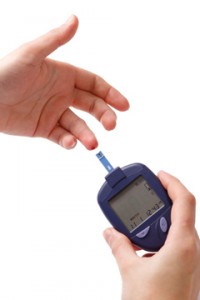Silent Killer: Diabetes
Posted on November 2, 2013 by bob in In Every Life
During American Diabetes Month it’s important to note Alabama’s population ranks near the top of states with diagnosed cases. Un-managed, diabetes is a major contributor to heart disease, stroke, kidney failure, nerve damage or new onset blindness.
The Centers for Disease Control estimates approximately 8% of the U. S. population is affected by diabetes, increasing to about 27% for those 65 and older. This further increases to approximately 50% percent for those 65 and older having pre-diabetes (measured by higher-than-normal fasting blood glucose or hemoglobin A1c levels). Individuals with pre-diabetes are at higher risk of developing diabetes, heart disease, hypertension or stroke.
Diabetes mellitus can occur at any age, and is a complex combination of changes that interrupt the body’s use of glucose (sugar). Insulin is produced in the pancreas to help the body metabolize and use carbohydrates, proteins and fats from foods. Without effective insulin, energy from food cannot be moved into body cells for use.
The American Diabetes Association recognizes four main categories of the disease:
Type 1 – Not enough insulin is produced. This accounts for about 5-10% of cases. It can be genetically linked or occur from an autoimmune response triggered by stress, illness, infection or chemical toxins (such as those in smoked or cured meats).
Type 2 – The body cells become resistant to insulin and/or insufficient insulin is produced. This is the most common form, accounting for about 90% of cases. It may also be genetically linked.
Gestational – Glucose intolerance first recognized during pregnancy.
Other Types – Genetic syndromes, pancreas diseases, chemical induced, and other various causes.
Each type of diabetes results in lower levels of glucose being transferred into body cells, causing higher glucose levels to remain in circulating blood. Each person has a unique response to the diabetes disease processes.
Individuals may:
– have no symptoms;
– experience fatigue, weight loss;
– experience one/more of the characteristic “3 poly’s”, polyuria (excessive urination), polydipsia (excessive thirst), polyphagia (excessive hunger).
Diabetes can be identified during routine physical exam blood-testing for glucose levels. Other times, results of changes to body organs such as blood vessels, heart, eyes, kidneys, or infection or delayed healing, prompt someone to seek healthcare, at which time increased blood glucose is identified. In yet other instances, diagnosis is made when an emergency situation occurs due to confusion or coma from acidosis.
Diabetes has no cure, and must be carefully managed throughout life. Treatment involves diet and exercise to moderate the amount of circulating sugar in the blood. Some individuals respond to medication that boosts the pancreas’ production of insulin, while others must receive replacement insulin through injections.
The goal of treatment is to keep blood glucose and lipid levels within a normal range and prevent or delay complications. Strong evidence has shown that optimal control of blood sugar can limit or prolong the effects on small blood vessels, such as those in the kidney and eye that contribute to kidney failure or visual impairment. Additionally, control of diabetes can limit changes in the nerves, especially in the lower extremities that cause tingling, numbness, or severe pain.
You can actively participate in your own healthcare by maintaining a healthy weight, adopting a healthy diet, and exercising. Keeping a personal health record of your annual blood glucose and lipid levels is also a good idea, along with documenting any changes in your body and discussing these with your healthcare provider.
If diagnosed with diabetes, careful adherence to diet, exercise, any medication, and home glucose monitoring are all critical components for prolonged well-being.
Arlene H. Morris, EdD, RN, CNE is Professor of Nursing, Auburn Montgomery School of Nursing. Reach her at amorris@aum.edu.










